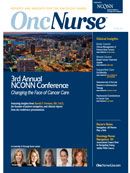Publication
Article
Oncology Nursing News
What is the best way to administer bendamustine, since some clinicians classify it as an irritant and others classify it as a vesicant?
Author(s):
Because of bendamustine's potential to cause pain and erythema to the extent that hospitalization has been required for some patients, it would be prudent to administer bendamustine using vesicant precautions.

On March 20, 2008, the FDA approved bendamustine hydrochloride (Treanda), an intravenously (IV) administered alkylating agent, for the treatment of patients with chronic lymphocytic leukemia (CLL). The recommended dose of bendamustine for CLL treatment is 100 mg/m2 administered IV over 30 minutes on days 1 and 2 of a 28-day cycle, up to 6 cycles.
On October 31, 2008, the FDA approved bendamustine for the treatment of patients with indolent B-cell non-Hodgkin lymphoma (NHL) that progressed during or within 6 months of treatment with rituximab or a rituximab-containing treatment regimen. For patients with indolent NHL, bendamustine is administered as a 60-minute IV infusion on days 1 and 2 of a 21-day cycle for up to 8 cycles. The recommended dose is 120 mg/m2.
A patient’s dose of bendamustine is placed in a 500-mL infusion bag of 0.9% Sodium Chloride Injection, USP (normal saline). As an alternative to normal saline, a 500 mL infusion bag of 2.5% Dextrose/0.45% Sodium Chloride Injection, USP, may be considered. The resulting final concentration of bendamustine in the infusion bag should be within 0.2-0.6 mg/mL.
Although the exact mechanism of action of bendamustine is unknown, it is a bifunctional mechlorethamine derivative that contains a purine-like benzimidazole ring. Mechlorethamine and its derivatives form electrophilic alkyl groups, and these groups form covalent bonds with electron-rich nucleophilic moieties, resulting in interstrand DNA crosslinks. This bifunctional covalent linkage can lead to cell death via several pathways; therefore, bendamustine is active against both dividing and resting cells.
Bendamustine prescribing information (PI) does not classify the drug as an irritant or vesicant and instructs clinicians to take precautions to avoid extravasation, including monitoring the intravenous infusion site during and after administration. The PI states that the manufacturer has received postmarketing reports of bendamustine extravasations that caused pain, erythema, and swelling and necessitated patient hospitalization. Precautions should be taken to avoid extravasation, including monitoring of the intravenous infusion site for redness, swelling, pain, infection, and necrosis during and after administration.
“
Because of bendamustine’s potential to cause pain and erythema to the extent that hospitalization has been required for some patients, it would be prudent to administer bendamustine using vesicant precautions. ”
In personal communication with the manufacturer on October 21, 2011, the manufacturer stated that limited data on bendamustine extravasation are available in the literature. A local tolerance study in an animal model indicated that bendamustine has the potential to produce irritation to the vein and surrounding tissue at concentrations of 0.2, 0.6, and 1.0 mg/mL. The manufacturer noted that when bendamustine is reconstituted and prepared as directed in the PI, it does not appear to be a vesicant but appears to be a local irritant upon infiltration into the tissue. In the event of an infiltration of bendamustine, immediate action should be taken to discontinue the infusion and remove the IV catheter (or non-coring needle from an implanted port). According to the manufacturer, there are no specific antidotes or treatment recommendations for bendamustine infiltration.
Because of bendamustine’s potential to cause pain and erythema to the extent that hospitalization has been required for some patients, it would be prudent to administer bendamustine using vesicant precautions (eg, use a new IV site in a large vein in the forearm, avoid using an IV infusion pump, and monitor the IV site and verify blood return every 5 to 10 minutes). Patients receiving bendamustine should be instructed to immediately report any change in sensation at the IV site, and report any unusual tugging or pulling on the IV tubing, which increase the risk of IV device or noncoring needle dislodgment.
If you have a clinical question for which evidence is lacking or controversial that you would like our experts to address, please submit it to jbroderick@onclive.com.










